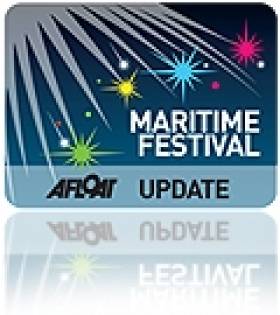Displaying items by tag: Red Arrows
Red Arrows To Perform at LegenDerry Maritime Festival
#clipperrace – The world-famous Red Arrows will take to the skies over the North West Coast of Ireland at the end of June with their display of daredevil aerial manoeuvres, to bring a spectacular close to the 2014 LegenDerry Maritime Festival.
Brought to the North West by a partnership between Donegal County Council, Limavady Borough Council and Derry City Council, the RAF Red Arrows will perform their thrilling flying display as the stunning send-off to the Clipper 2013-14 Round the World Yacht Race on Sunday 29th June 2014.
The distinctive red jets, which are this year celebrating their 50th display season, will execute their trademark formations, close-passes and dynamic loops and rolls at the mouth of the River Foyle between Greencastle in Co. Donegal and Magilligan/Binevenagh in Co. Londonderry.
Thousands of people are expected to descend upon the North West Coast to capture a clear vantage point of the Red Arrows' stunning performance and celebrate the official Race Start of the Clipper 2013-14 Race at Greencastle, Co. Donegal.
Mayor of Donegal County Council, Councillor Ian McGarvey said: "Along with my fellow Mayors from Derry City Council and Limavady Borough Council I am delighted to confirm the staging of this spectacular Red Arrows event. I am sure this will attract visitors from across the region and beyond to the Lough Foyle area. Their exciting air display will be an excellent way to see off the Clipper Race as the fleet prepares to sets sail off the coast of Greencastle. I hope that everyone who comes to Donegal has a safe and enjoyable time."
Mayor of Limavady, Councillor Gerry Mullan said: "I am delighted to welcome back the spectacular Clipper Race event and am looking forward to seeing the boats sailing into Lough Foyle past Magilligan Point. I wish all the crews a warm welcome to the area and hope they get the chance to explore all it has to offer when they come ashore."
Mayor of Derry City Council, Councillor Martin Reilly said: "It is a major coup to have the Red Arrows perform and their display will provide a suitably spectacular final flourish to our week-long LegenDerry Maritime Festival. We are delighted to have been able to facilitate this in partnership with our friends in Limavady and Donegal, who are bringing the world-famous Red Arrows here.
"Our stunning North West coastline will provide the perfect backdrop for the official Race Start of the Clipper 2013-14 Round the World Yacht Race. We are thrilled that thousands of local people will be able to share the celebrations and the spectacle on land, on the sea and now, also in the sky."
Derry~Londonderry is the penultimate stopover for the Clipper 2013-14 Race, the world's longest ocean race. After a gruelling journey of almost 40,000 miles, 11 month circumnavigation of the globe the City will welcome the 12-strong fleet of Clipper Race yachts back to the city, including its very own Derry~Londonderry-Doire yacht, with a weeklong LegenDerry Maritime Festival from 21st - 29th June 2014.
The LegenDerry Maritime Festival will transform the River Foyle's quayside into a summer promenade, with race village, award winning continental market, seafood festival, music extravaganza and a host of sea-faring activities on and off shore for families, sailors and land-lubbers alike.
No Red Arrows for VOR Galway
#VOLVO OCEAN RACE - Red Arrow jets will not be returning to the skies over Galway Bay when it hosts the Volvo Ocean Race finale this summer, the Galway Sentinel reports.
The Royal Air Force (RAF) has turned down a request by event organisers to bring its aerobatic display to the City of the Tribes citing 'operational reasons'.
It is understood that the RAF is reducing the number of Red Arrows performances this year due to a shortage of pilots trained to do air displays.
The Red Arrows flyover was one of the highlights of Galway's 2009 hosting of the yacht race.
However, their proposed return was opposed by anti-war campaigners the Galway Alliance Against War, who issued a statement last week declaring the the RAF and another "war outfit" were lined up as entertainment for the race week.
The Galway Sentinel has more on the story HERE.






























































